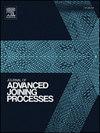Neutron diffraction analysis of residual stress distribution in the lubricant-free TR-AFSD AA7075 repair coupled with SPH simulations
IF 3.8
Q2 MATERIALS SCIENCE, MULTIDISCIPLINARY
引用次数: 0
Abstract
This work examines the residual stress in high-strength aluminum alloy repaired by lubricant-free additive friction stir deposition (AFSD) using the same aluminum alloy feedstock. Specifically, a milled groove in an AA7075-T651 substrate was repaired using the twin rod additive friction stir deposition (TR-AFSD) without using any graphite lubricant on the feedstock materials, which is required for conventional square feedstock AFSD. Residual stress distribution in the repaired substrate at different depths was quantified via neutron diffraction, where the distribution of longitudinal residual stress in the TR-AFSD repair was found comparable to materials subjected to other friction-based processes, with an M-shaped or bell-shaped distribution. The tensile longitudinal residual stress, with a peak of 171.3 MPa, spanned the center region around 36 mm, while compressive longitudinal residual stresses, ranging between -112.9 MPa and -12.3 MPa, were balanced outside the center at both the advancing side and retreating sides. The transverse and normal residual stresses were consistent across the repair, with smaller magnitudes between -52 MPa and 68.3 MPa. The non-destructive and high penetration depth nature of the neutron diffraction method enabled the calculation of von Mises stress by interpreting the three measured orthogonal residual stresses as the principal stresses. By normalizing the calculated von Mises stress to the microhardness, this quantified ratio indicates the influence of the embedded residual stresses relative to the material's strength. The higher normalized ratio observed at a deeper depth closer to the bottom of the repair, suggests that the magnitude of residual stresses is closer to the material's strength, indicating a higher potential for residual stress-induced failure at this location. We also calibrated the state-of-the-art smooth particle hydrodynamic (SPH) TR-AFSD process model to predict the von Mises stress distribution in the TR-AFSD AA7075 repair. The experimentally measured residual stress, coupled with the SPH simulation, could further help the research community to minimize the tensile region and alleviate substrate distortion in materials subjected to friction-based processes.
无润滑油TR-AFSD AA7075修复中残余应力分布的中子衍射分析与SPH模拟
本文研究了使用相同的铝合金原料进行无润滑油添加剂搅拌摩擦沉积(AFSD)修复的高强度铝合金的残余应力。具体来说,使用双棒添加剂搅拌摩擦沉积(TR-AFSD)修复AA7075-T651衬底上的铣削槽,而无需在原料上使用任何石墨润滑剂,而传统的方形原料AFSD需要石墨润滑剂。通过中子衍射量化了修复基板在不同深度的残余应力分布,其中发现TR-AFSD修复中的纵向残余应力分布与经历其他摩擦工艺的材料相当,呈m形或钟形分布。纵向拉伸残余应力的峰值为171.3 MPa,横跨中心区域约36 mm,纵向压缩残余应力的峰值在-112.9 MPa ~ -12.3 MPa之间,在中心外侧的推进侧和后退侧均保持平衡。横向残余应力与正法向残余应力在整个修复过程中一致,在-52 MPa ~ 68.3 MPa之间。中子衍射法具有非破坏性和高穿透深度的特点,可以将测得的三个正交残余应力解释为主应力来计算von Mises应力。通过将计算得到的von Mises应力归一化到显微硬度,这个量化的比值表明了相对于材料强度的嵌入残余应力的影响。在接近修复底部的更深深度处观察到更高的归一化比,表明残余应力的大小更接近材料的强度,表明该位置的残余应力诱发破坏的可能性更高。我们还校准了最先进的光滑颗粒流体动力学(SPH) TR-AFSD过程模型,以预测TR-AFSD AA7075修复中的von Mises应力分布。实验测量的残余应力,加上SPH模拟,可以进一步帮助研究团体最小化拉伸区域,减轻材料在摩擦过程中的基板变形。
本文章由计算机程序翻译,如有差异,请以英文原文为准。
求助全文
约1分钟内获得全文
求助全文

 求助内容:
求助内容: 应助结果提醒方式:
应助结果提醒方式:


